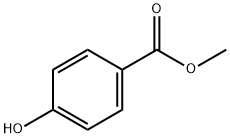Heptyl 4-Hydroxybenzoate , >98.0%(HPLC) , 1085-12-7
CAS NO.:1085-12-7
Empirical Formula: C14H20O3
Molecular Weight: 236.31
MDL number: MFCD00016481
EINECS: 214-115-0
| Pack Size | Price | Stock | Quantity |
| 25G | RMB304.00 | In Stock |
|
| 100G | RMB768.00 | In Stock |
|
| 500G | RMB2312.00 | In Stock |
|
| others | Enquire |
PRODUCT Properties
| Melting point: | 46-51 °C |
| Boiling point: | 338.77°C (rough estimate) |
| Density | 1.0717 (rough estimate) |
| refractive index | 1.5800 (estimate) |
| storage temp. | Sealed in dry,Room Temperature |
| solubility | Chloroform (Slightly), Methanol (Slightly) |
| form | Solid |
| pka | 8.23±0.15(Predicted) |
| color | White to Off-White |
| Water Solubility | Soluble in alcohol, phenoxyethanol, propylene glycol. Insoluble in water. |
| LogP | 4.830 |
| CAS DataBase Reference | 1085-12-7(CAS DataBase Reference) |
| NIST Chemistry Reference | Benzoic acid, 4-hydroxy-, n-heptyl ester(1085-12-7) |
| EPA Substance Registry System | Benzoic acid, 4-hydroxy-, heptyl ester (1085-12-7) |
Description and Uses
Hesperidin is one of a large group of bio-flavonoids isolated from
citrus fruits. Flavonoids comprise a group of naturally occurring
compounds which are among the most ubiquitous in the plant
kingdom. The basic flavone structure consists of 1,4-benzopyrone
with a phenyl substitution in the 2-position. Flavonoids differ in
the number and position of substitutions on the aromatic rings and
in the extent and character of oxidation in the pryone portion of
the molecule. Hydroxyl groups enable flavonoids to combine with
sugars to form glycosides, and it is in this form that the flavonoids
are usually found in nature. Glucose is the most common prosthetic
group, although other sugars, as well as glucuronic and galacturonic
acids, have been identified. Hesperetin is the aglycone
remaining following hydrolysis from the prosthetic group.
Hesperidin complex is a crude hesperidin preparation obtained by
extraction of the albedo of orange peel with calcium hydroxide
solution. On acidification with hydrochloric acid to pH about 4.5,
hesperidin precipitates as a crystalline material along with other
co-precipitated flavonoids. The precipitate is washed to remove
non-flavonoid ballast, and then spray dried. Average hesperidin
content is 72%; naringenin-7-rutinoside, 4.4%; isosakuranetin-
7-rutinoside, 4.2%; and less than 1% naringenin-7-rutinoside-4’-
glucoside, eriocitrin, sinensetin, bobeletin, tangeretin, and several
unidentified polymethoxylated flavones. It contains no rutin. The
powdered precipitate is nonhygroscopic; its weight loss on drying
is 2-5%; sulfated ash, 2-4%; and methoxyl content, 3.3-3.7%.
Purified hesperidin is prepared from hesperidin complex by dissolving
the crystals in calcium hydroxide solution and precipitating
by acidification with hydrochloric acid. More than one cycle
of dissolution and precipitation may be needed to achieve the minimum hesperidin content of 80% specified for the purified
product. Most purified product is stated to have a hesperidin content
of 90%.
Hesperidin is practically tasteless. Presumably through its action
as an antioxidant, hesperidin has been reported to delay flavor
deterioration of milk-based beverages, thereby extending shelf life
by 6-12 months. Hesperidin also is used as a reagent in the refining
and reclaiming of lead and zinc, and as a raw material in the
production of the dihydrochalcone of neohesperidin, a nonnutritive
sweetener.
Food additive.
Safety
| Symbol(GHS) |  GHS07 |
| Signal word | Warning |
| Hazard statements | H315-H319-H335 |
| Precautionary statements | P261-P280a-P304+P340-P305+P351+P338-P405-P501a |
| Hazard Codes | Xi |
| Risk Statements | 36/37/38 |
| Safety Statements | 37/39-26-37 |
| RTECS | DH2202000 |
| TSCA | Yes |
| HS Code | 29182900 |



